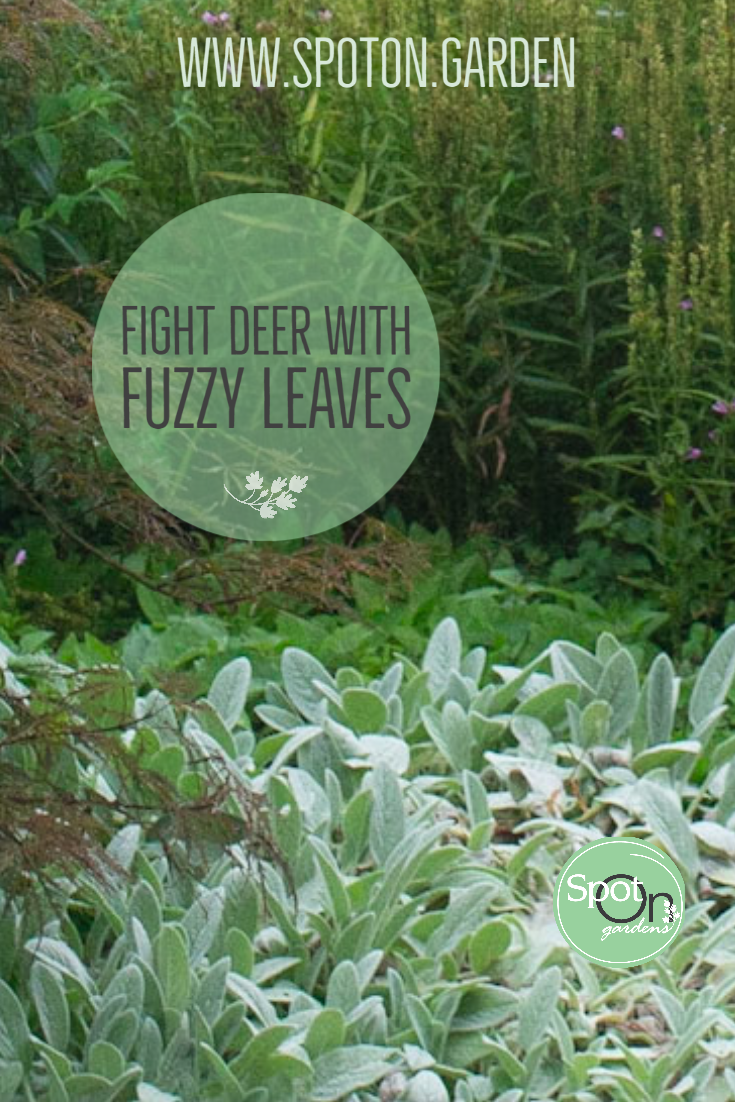Fuzzy Fighters
- Helen Newling Lawson

- May 24, 2018
- 3 min read
Updated: Jul 23, 2020
"Fuzzy" brings to mind things like teddy bears and distant memories. Soft, comforting, but certainly not powerful. Change all that thinking when it comes to fuzzy plants. In the fight against deer browsing, they're one of your most effective tactics.

Hairy-leaved plants are one of the main five categories of plants that deer don't like. The other four are prickly, smelly, bad-tasting, and toxic. In a series of upcoming blog posts, I'll do a deep dive on each type. We'll take a look at some widely-available plant choices that fit the category, and some ideas for using them in deer-resistant designs.
Top Deer-Resistant Fuzzy Plants
Lambs ear (Stachys byzantina)
Lady's mantle (Alchemilla mollis)
Wormwood (Artemesia)
Dusty miller (Centaurea cineraria)
Mountain bluet (Centaurea montana)
Blanket flower (Gaillardia)
Bush clover (Lespedeza thunbergii)
Cinnamon fern (Osmunda cinnamomea)
Bush cinquefoil (Potentilla fruticosa)
Lavender cotton (Santolina chamaecyparissus)
Black Sea comfrey (Trachystemon orientalis)
Deer-Resistant Design Ideas For Fuzzy Plants

Fuzzy-leaved plants that have a silvery cast are perfect for designing white gardens. In a white garden, made famous by one planted at Sissinghurst, the dominant plant color is white -- either bloom or foliage. The effect is cool, restful, and elegant by day, and luminous by night. The style is generally fairly formal and orderly, with wide paths -- possibly because they are designed to be enjoyed when the light is getting low and footing needs to be more secure. White gardens also often uses structures like arbors and gazebos (also painted white, of course). These provide a nice place to stop and enjoy the evening.
Lamb's ear (Stachys byzantina, seen at the top of this post), dusty miller (Centaurea cineraria), and wormwood (Artemesia) all have interesting silvery foliage that will add sparkle to a white garden by day and glow when the sun goes down. Dusty miller is shown in the foreground, below, with lamb's ear for a color echo across the courtyard.

If you prefer lots of color over a monochromatic look, create a low-maintenance, flower-filled

cottage garden with 'Amethyst in Snow' mountain bluet (Centaurea montana) or bush clover (Lespedeza thunbergii). If you garden in a cooler climate, you can also try bush cinquefoil (Potentilla fruticosa). This deciduous shrub is native to the northern reaches of North America, and will also attract butterflies to its nectar-filled flowers. The species has yellow blooms, but two new selections from the Bloomin' Easy line, Bella Bellissima(TM), shown right, and Bel Sol(TM), have expanded the color options into rich rose and deep orange. (Photo courtesy of Van Belle Nursery)

Some hairy plants have developed their down to help them protect against drought and moisture loss. Light reflected off the fine hairs often give the leaves a silvery cast. Whenever I see a silver or gray-leaved plant, it tips me off to check if it's also a deer-resistant plant.
Plants that are fuzzy for heat protection, like blanket flower (Gaillardia), and lavender cotton (Santolina), are great choices for a full-sun, dry soil site, or a low-water Xeriscape design.
Three fuzzy plants that buck the trend of silvery sun lovers are cinnamon fern (Osmunda cinnamomea), lady's mantle (Alchemilla mollis) and Black Sea comfrey (Trachystemon orientalis). All like moist soil and partial shade.

Cinnamon fern is a great fern, native to the US. The name comes from the spires of new fronds that
emerge looking like a cinnamon stick (see right). Fun fact: ruby-throated hummingbirds use the down from the hairy fronds to line their nests.
Lady's mantle is a great multi-purpose edging plant with scalloped leaves similar to coral bell (Heuchera) and sprays of chartreuse flowers. Unfortunately, it needs a cooler climate and more reliable moisture than my garden offers.
'Sundew' Black Sea comfrey was recently named by the editors of Fine Gardening as their favorite new plant introduction for 2018. They actually called it deer-proof, but those are their words, not mine. This variety of a sometimes invasive species packs a punch with large vibrant yellow fuzzy leaves, and the dense clump will eventually spread to form a ground cover. Talk about brightening up a shady corner!
Like this article? Pin it!








Comments